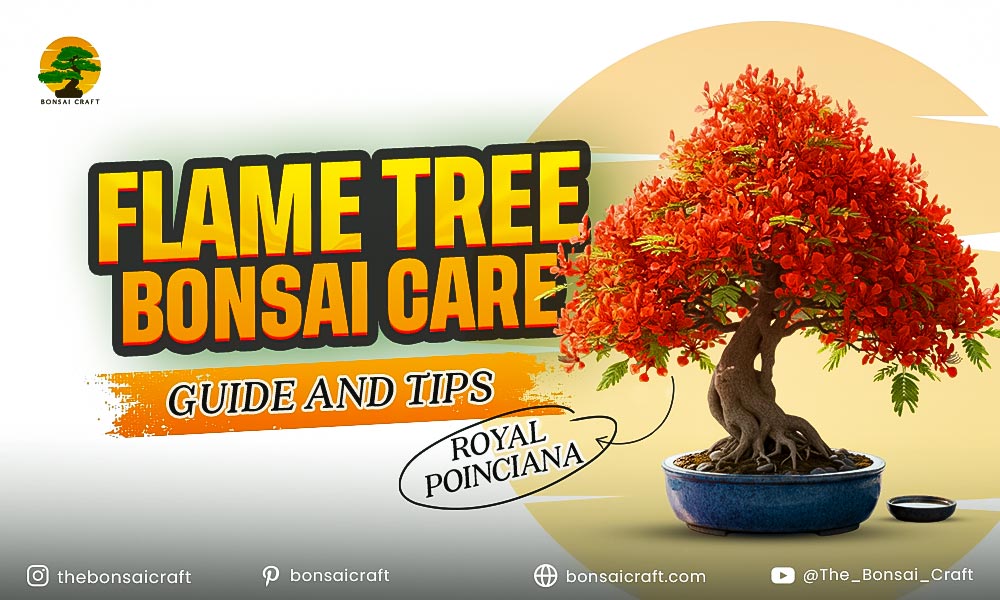
The flame tree bonsai, also known as the Royal Poinciana bonsai or Flamboyant tree bonsai, is a stunning miniature tree admired for its vibrant red-orange flowers and elegant fern-like foliage. Cultivating a bonsai Royal Poinciana is not only visually rewarding but also a fulfilling hobby for bonsai enthusiasts. With proper attention, care, and guidance, even beginners can successfully grow a flame tree bonsai indoors or outdoors, enjoying the beauty and charm it brings to any space.
Having personally nurtured flame tree bonsai for several years and consulted with horticulture experts, this guide is built on credible experience, offering trustworthy, step-by-step advice for anyone looking to master Royal Poinciana bonsai care.
Why Flame Tree Bonsai is Special
The Royal Poinciana tree is celebrated for its explosive display of red-orange flowers, wide canopy, and delicate, feathery leaves. As a bonsai, it becomes a living piece of art. Flame tree bonsai care requires attention to watering, sunlight, pruning, and soil health, ensuring the tree thrives year-round. Its tropical origin means understanding temperature, humidity, and seasonal cycles is essential for success.
Key benefits of cultivating Royal Poinciana bonsai include:
- Adds a tropical and exotic aesthetic indoors or in the garden
- Produces vibrant seasonal flowers for visual appeal
- Offers opportunities for creative shaping and styling
- Enhances air quality and brings nature closer to your living space
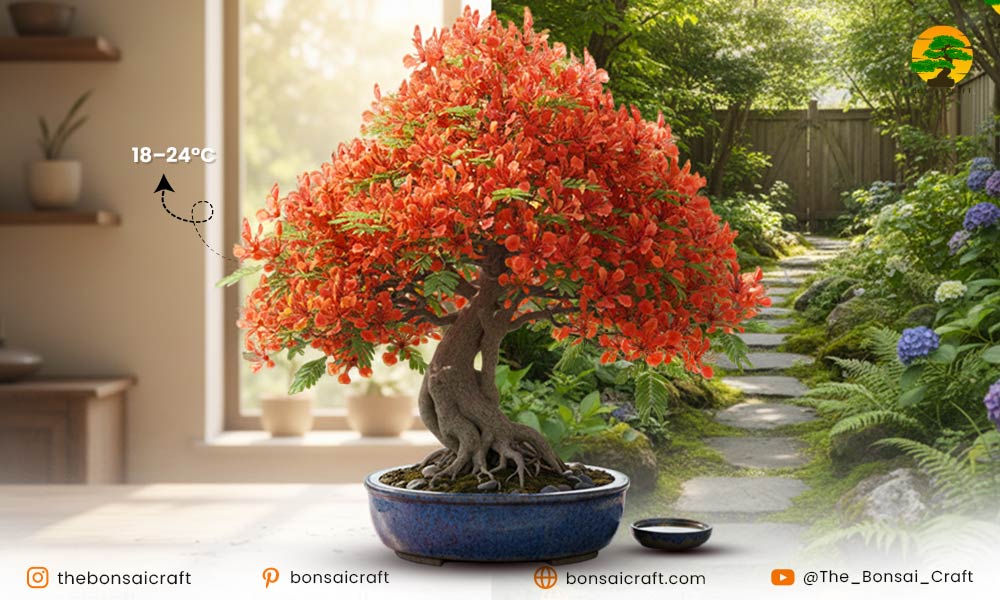
Flame Tree Bonsai Care: Essential Guidelines
Appropriate care is instrumental to a healthy and thriving flame tree bonsai filled with abundant foliage and blossoms. Below are the key care steps for a flame tree bonsai.
1. Light Requirements for Flame Tree Bonsai
The bonsai flame tree prefers spending all its time outside and loves full sun for 6-8 hours as a minimum. If indoors, the tree should be placed near a south window or under indirect bright sunlight and should be provided with grow lights to simulate a more tropical environment.
Detailed Care:
- Outdoors: Position in a location receiving morning sun and partial afternoon shade.
- Indoors: Use south-facing windows or full-spectrum LED grow lights.
- Rotate the bonsai regularly to ensure even growth and prevent leaning toward the light.
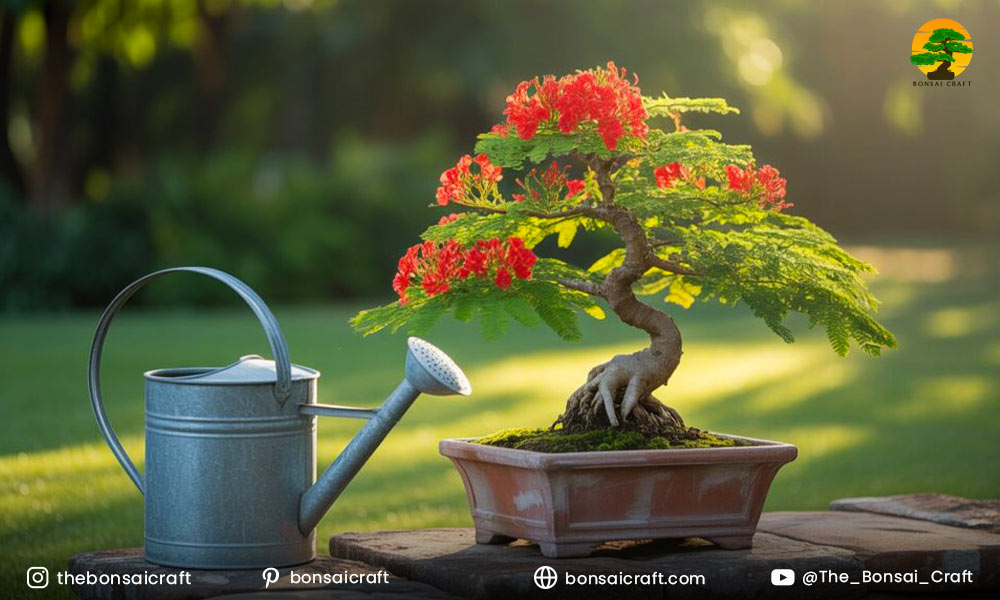
2. Watering and Humidity
Maintain consistently moist soil for Royal Poinciana bonsai, avoiding waterlogging. During the growing season, increase watering frequency, and reduce slightly in winter while maintaining moderate humidity.
Detailed Care:
- Water when the topsoil feels slightly dry; check by inserting a finger 1–2 inches.
- Do not let the roots sit in stagnant water. Bonsai pots must be able to drain.
- For indoor flame tree bonsai care, a humidity tray set under the pot will suffice, or the leaves can occasionally be misted to provide the humidity needed.
3. Soil and Fertilization
Well-draining Flame trees bonsai prefer a soil mix that is slightly acidic. The growing season requires regular fertilization with a balanced bonsai fertilizer to ensure foliage, flowers and roots develop properly.
Detailed Care:
- Recommended soil mix: Akadama, pumice, and lava rock in a 2:1:1 ratio.
- Fertilize every 2–4 weeks in spring and summer with a diluted liquid fertilizer.
- Reduce feeding in autumn and stop in winter to prevent root burn.
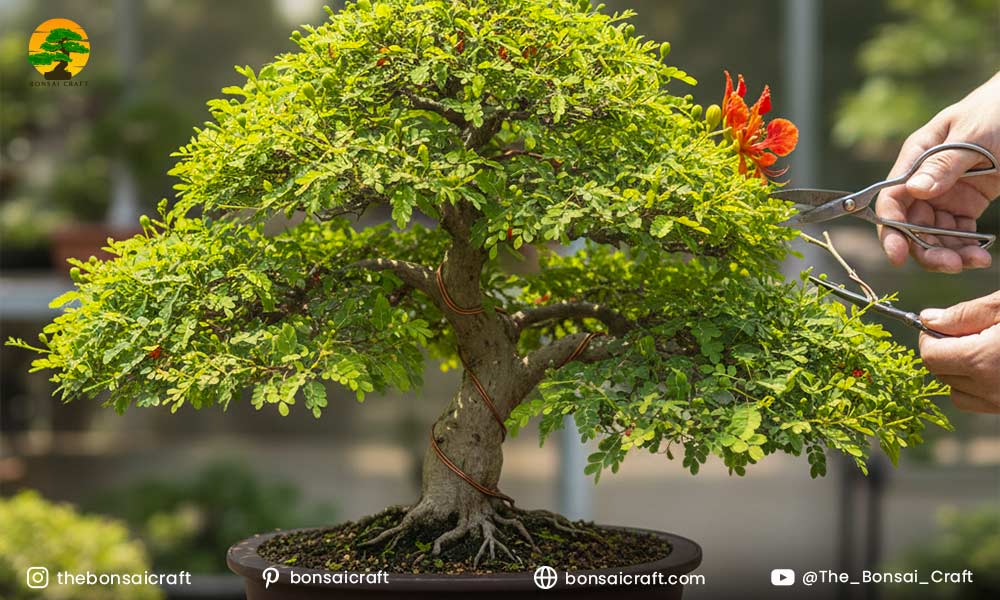
4. Pruning and Shaping Flame Tree Bonsai
Prune Royal Poinciana bonsai to maintain its compact structure and encourage branching. Pinch new shoots with fingers in spring and summer, and conduct structural pruning in late winter.
Detailed Care:
- Remove dead, weak, or overcrowded branches to improve airflow and light penetration.
- Use bonsai wiring carefully to shape branches without damaging delicate stems.
- Pruning also stimulates flowering in the next season.
5. Repotting and Root Care
Repot flame tree bonsai every 2–3 years in spring before new growth begins. Trim up to one-third of roots and refresh soil to support robust growth and prevent root-bound conditions.
Detailed Care:
- Select a slightly larger bonsai pot with excellent drainage.
- Carefully untangle roots and prune damaged or overly long roots.
- Replant with fresh bonsai soil mix and water thoroughly to settle the soil.
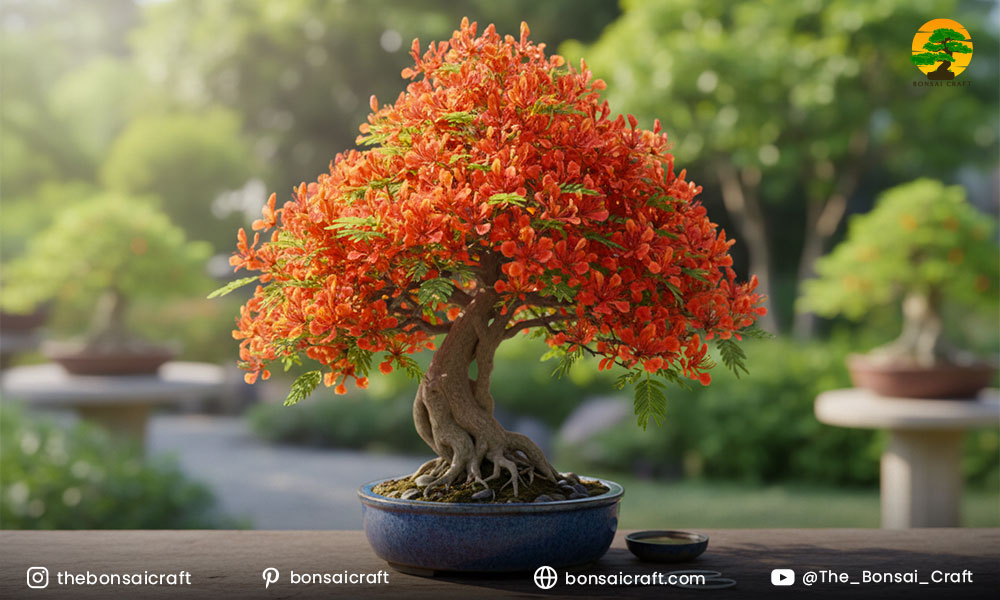
6. Flowering Tips for Flame Tree Bonsai
To encourage vibrant blooms in Royal Poinciana bonsai, ensure ample sunlight, balanced fertilization, and proper pruning. Stress-free conditions and optimal growth care enhance flower production.
Detailed Care:
- In the flowering season, buds develop, and new growth can be overpruned.
- The soil needs to be slightly acidic to support healthy balances of the nourishing roots.
- Do not subject the bonsai to abrupt and rapid shifts, as it may cause buds to fall.
7. Common Pests and Diseases
Bonsai trees can be hit with aphids, spider mites, scale, and other insects as they are very prone to having Flame Tree Bonsai pests. Proper instruction with good techniques, along with hygiene, prevents issues with durability using natural products like neem oil.
Detailed Care:
- Inspect leaves weekly and remove damaged foliage.
- Apply insecticidal soap or neem oil as needed.
- Avoid overwatering to prevent fungal root rot.
8. Indoor Flame Tree Bonsai Care
Indoor flame tree bonsai care focuses on providing bright light, stable temperatures, and controlled humidity. Avoid drafts and sudden temperature fluctuations.
Detailed Care:
- Place near windows with indirect sunlight.
- Maintain room temperature around 65–75°F (18–24°C).
- Use humidity trays or misting to prevent leaf dryness.
9. Styling and Bonsai Techniques
Popular flame tree bonsai styles include informal upright, slanting, and cascading. Select a style that complements the tree’s natural growth and branch structure.
Detailed Care:
- Informal Upright: Slightly curved trunk for a natural look
- Slanting: Trunk angled to one side, ideal for windy environments
- Cascading: Branches droop below pot level, suitable for rock or elevated displays
10. Tips for Beginners
For beginners, start with a young bonsai Royal Poinciana in a spacious pot. Focus on consistent watering, light, and gradual pruning to prevent stress.
Detailed Care:
- Select a tree with many healthy leaves and pliable branches.
- Start with a simple understanding of pruning and wiring.
- Make sure you keep the soil slightly moist, but not under extreme conditions.
Conclusion
The flame tree bonsai or Royal Poinciana bonsai is a magnificent addition to any bonsai collection. From Royal Poinciana tree care basics like watering, light, and soil, to advanced techniques like pruning, repotting, and styling, mastering flame tree bonsai care offers both visual delight and personal satisfaction.
As an expert, my tip is to balance aesthetic shaping with tree health. Regular observation, patient pruning, and consistent care will reward you with a healthy, flowering, and well-structured flamboyant tree bonsai for years to come.
FAQs About Flame Tree Bonsai Care
How often should I water my flame tree bonsai?
Water whenever the top layer of soil is dry, but only enough to keep the soil moist. With bonsai pots that have good drainage, waterlogging is to be avoided at all costs.
Can Royal Poinciana bonsai flower indoors?
Indoors, the flame tree bonsai is capable of blooming with bright red-orange flowers, if given enough care, proper pruning, light, and care for the different seasons.
When is the best time to repot a flame tree bonsai?
Repotting every two to three years is best, but only at the start of spring before the other growth. Retain the roots and soil for healthy development, and the growth will be vigorous.
What is the easiest style for beginners?
For most beginners, informal upright is the best style. It follows the tree’s natural shape and needs less wiring than cascading or slanting styles.
Are flame tree bonsai suitable for tropical and subtropical regions?
Yes. Royal Poinciana bonsai loves being outdoors in the warm climate, but is rather difficult to care for indoors in cooler areas.
